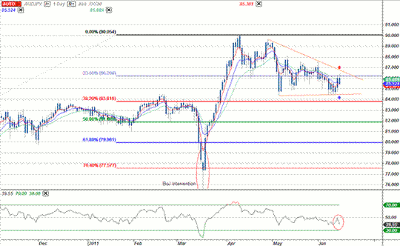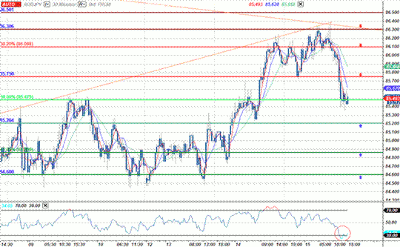A promising scalp trade opportunity has emerged in the AUD/JPY currency pair. Here are the key price levels and risk factors to watch, as well as events that could invalidate the short-term set-up.
The Australian dollar/Japanese yen currency pair (AUD/JPY) has continued to bottleneck into a wedge formation dating back to late April after making fresh multi-year highs at the 90 handle.
Earlier this week, we saw the aussie fail an attempted breach of the 23.6% Fibonacci extension taken from the April 30, 2010, and April 11, 2011 crests at 86.20.
Here is a daily chart:
With the sharp decline in global equity markets seen mid week, the pair presents opportunities to scalp risk-aversion flows as traders jettison the high-yielding aussie for the safety of the greenback, the Swiss franc, and the yen.
Accordingly, our bias on this particular scalp is to the downside, noting that a swing in sentiment could quickly see this set-up become invalidated. With that in mind, note that the encompassing trend since the April highs has been bearish with longer-term downside targets eyeing key support at the 38.2% Fibonacci extension.
A recent 30-minute chart reveals the AUD/JPY pair resting on interim support at the 50% extension taken from the April 27 and May 11 crests at 85.50:
Preferred short-entry targets are held here, followed by 85.75, and the 38.2% extension just above the 86 handle. Support targets are seen at 85.20, the 61.8% Fib extension at 84.90, and 84.60.
With a two-hour average true range of 30.46, profit targets for said scalp should be between 18 and 26 pips, depending on entry. Note that the trade will not be in play until a confirmed break of the 50% extension at 85.50 or a re-test of the 85.75 interim resistance level.
Once the trade is active, the scalp will remain in play until such time when either of the top or bottom limit targets is breached.
NEXT: Key Price Levels and Risk Factors to Watch
|pagebreak|Key Thresholds
A daily Relative Strength Index (RSI) reading of 39.2 suggests plenty of downside potential for our scalp. However, it also suggests that a reversal in price action would see much more topside potential.
Accordingly, we reckon a breach above the topside limit at 86.30 negates the bearish bias on the trade with such a scenario eyeing the topside break target at 86.50. Likewise, a break below the bottom limit at 84.60 risks further losses for the aussie, with subsequent floors seen at the 84.40 and the 76.4% Fib extension at 84.10.
Notwithstanding further developments regarding Greece, event risk for the pair is rather negligible for the remainder of the week. The Australian economic docket wraps up the week early with consumer inflation expectations, new car sales, and RBA foreign transactions for the month of May. Highlighting Japan’s economic calendar will be the release of the BoJ meeting minutes at 23:50 on Thursday.
More: View Economic Calendar here
The largest risk to this specific scalp will be swings in market sentiment, with a pick-up in risk seen as the biggest threat to our bias. If haven flows continue to see traders moving into lower-yielding, “safe” assets, the scalp will perform exceptionally well. However, if markets brush off the recent disappointing data and risk appetite picks up, the reversal would see the yen come off as traders unwind risk-aversion flows for higher-yielding currencies like the aussie, which boasts the highest interest rate of the developed economies. Such a scenario would invalidate our bias, with the topside resistance targets now used as profit limits on long positions.
By Michael Boutros, currency analyst, DailyFX.com























